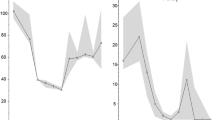Abstract
Local cerebral glucose utilization (LCGU) was studied in 35 conscious rats after a fluid percussion injury (cerebral contusion). The experiments were divided into two parts.
-
(I)
Natural course: LCGU was quantitatively measured in 17 rats by the14C-deoxyglucose autoradiographic method (Sokoloff et al. 1977) at 1, 2, 4 and 24 hours after injury. Sham operation was made in six rats.
-
(II)
DC-potential and LCGU: LCGU was studied with DC-potential and EEG monitoring in 12 rats.
Results were as follows: (I) i) Glucose uptake was reduced at the center of the contusion in all cases. ii) Two different effects were observed in LCGU change two hours after injury: normal or slight increase in four of six rats (type A) and a remarkable increase in the cortex of the injured hemisphere in two of six rats (type B). iii) The pattern of increase in LCGU (type B) resembles that of cortical spreading depression.
(II) i) Negative shift of DC-potential concomitant with EEG suppression in the injured hemisphere was observed frequently one to two hours after injury. ii) The increased LCGU pattern during DC-potential negative shift was identical with that of type B. iii) LCGU pattern without DC-potential change resembles that of type A.
We concluded that the hypermetabolism occurring in the damaged cortex was due to a spreading depression. The findings obtained here should yield very important information concerning pathogenesis and treatment of human head injury.
Similar content being viewed by others
References
Albe-Fessard D., Sanderson P., Condes-Lara M., et al.: Utilisation de la depression envahissante de Leao pour l'étude de relations entre structures centrales. An. Acad. brasil. Cienc. 56: 371–383, 1984
Bruc D.A., Langfitt T.W., Miller J.D., et al.: Regional cerebral blood flow, intracranial pressure, and brain metabolism in comatose patients. J. Neurosurg 38: 131–144, 1973
Crockard H.A., Brown F.D., Trimble J., et al.: Somatosensory evoked potentials, cerebral blood flow and metabolism following cerebral missile trauma in monkeys. Surg. Neurol. 7: 281–287, 1977
Cisba L., Paschen W., Mies G.: Regional changes in tissue pH and glucose content during cortical spreading depression in rat brain. Brain Research 336: 167–170, 1985
Fifkova E., Bures J.: Spreading depression in the mammalian striatum. Arch. Int. Physiol. Bioch. 72: 171–179, 1964
Gjedde A., Hansen A.J., Quistorff B.: Blood-brain glucose transfer in spreading depression. J. Neurochem. 37: 806–812, 1981
Hansen A.J., Quistorff B., Gjedde A.: Relationship between local changes in cortical blood flow and extracellular K+ during spreading depression. Acta Physiol. Scand. 109: 1–6, 1980
Hansen A.J., Zeuthen T.: Extracellular ion concentrations during spreading depression and ischemia in the rat brain cortex. Acta Physiol. Scand. 113: 437–445, 1981
Hass W.K.: Prognostic value of cerebral oxidative metabolism in head trauma. In: McLaurin R.L. (Ed): Head Injuries. New York, Grune & Stratton, 35–37, 1976
Hawkins R.A., Hass W.K., Ransohoff J.: Cerebral blood flow, glucose utilization, oxidative metabolism, and plasticity after mesencephalic reticular formation lesions. In: Popp A.J., Bourke R.S., Nelson L.R., et al.: (Eds): Neural Trauma. New York, Raven Press, 9–16, 1979
Hayes R.L., Pechura C.M., Katayama Y., et al.: Activation of pontine cholinergic sites implicated in unconsciousness following cerebral concussion in the cat. Science 223: 301–303, 1984
Lauritzen M., Jorgensen M.B., Diemer N.G., et al.: Persistent oligemia of rat cerebral cortex in the wake of spreading depression. Ann. Neurol 12: 469–474, 1982
Leao A.P.: Spreading depression of activity in the cerebral cortex. J. Neurophysiol. 7: 357–390, 1944
Meyer J.S., Kondo A., Nomura F., et al.: Cerebral hemodynamics and metabolism following experimental head injury. J. Neurosurg 32: 304–319, 1970
Mutch W.A.C., Hansen A.J.: Extracellular pH changes during spreading depression and cerebral ischemia: Mechanisms of brain pH regulation. J. Cerebral Blood Flow Metabol. 4: 17–27, 1984
Nelson S.R., Lowry O.H., Passonneau J.V.: Changes in energy reserves in mouse brain associated with compressive head injury. In: Caveness W.F., Walker A.E. (Eds): Head Injury. Philadelphia, Lippincott, 444–447, 1966
Nilsson B., Nordstrom C.H.: Experimental head injury in the rat. Part 3: Cerebral blood flow and oxygen consumption after concussive impact acceleration. J. Neurosurg. 47: 262–273, 1977
Overgaard J., Tweed W.A.: Cerebral circulation after head injury. Part 4: Functional anatomy and boundary-zone flow deprivation in the first week of traumatic coma. J. Neurosurg. 59: 439–446, 1983
Pappius H.M.: Local cerebral glucose utilization in thermally traumatized rat brain. Ann. Neurol. 9: 484–491, 1981
Shah K., West M.: The effect of concussion on cerebral uptake of 2-deoxy-d-glucose in rat. Neuroscience Letters 40: 287–291, 1983
Shinohara M., Dollinger B., Brown G., et al.: Cerebral glucose utilization: Local changes during and after recovery from spreading cortical depression. Science 203: 188–190, 1979
Sokoloff L.: Localization of functional activity in the central nervous system by measurement of glucose utilization with radioactive deoxyglucose. J. Cerebral Blood Flow Metabol. 1: 7–36, 1981
Sokoloff L., Reivich M., Kennedy C., et al.: The14C-deoxyglucose method for the measurement of local cerebral glucose utilization: Theory, procedure, and normal values in the conscious and anesthetized albino rat. J. Neurochem. 28: 897- 916, 1977
Sramka M., Brozek G., Bures J., Nadvornik D.: Functional ablation by spreading depression. Possible use in human stereotactic neurosurgery. Appl. Neurophysiol. 40: 48–61, 1977/78
Author information
Authors and Affiliations
Rights and permissions
About this article
Cite this article
Sunami, K., Nakamura, T., Ozawa, Y. et al. Hypermetabolic state following experimental head injury. Neurosurg. Rev. 12 (Suppl 1), 400–411 (1989). https://doi.org/10.1007/BF01790682
Issue Date:
DOI: https://doi.org/10.1007/BF01790682



